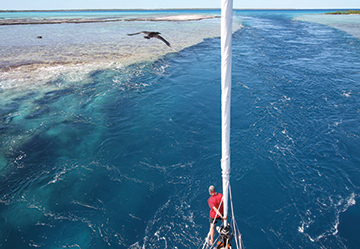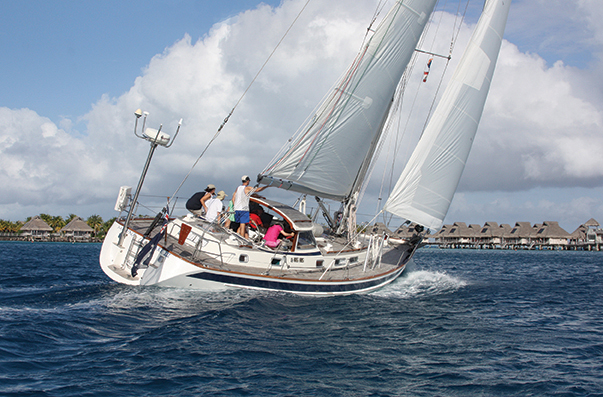Highlights from Mahina Expeditions’ 2014 Pacific training season and a look forward to future voyages (published December 2014)
It was a typical Pacific Northwest fall day, grey and spitting rain, when I walked from my boat to the Mahina Expeditions office in Friday Harbor, Washington. I hadn’t seen John and Amanda since January at the Seattle Boat Show, so it was nice to spend an afternoon hearing how their 2014 training passages went and to find out what they have in store for 2015 and beyond.
After chatting in the office, John and I hopped in his car and took a lunch down to Jackson Beach where we sat at a picnic table to cover a wide range of topics. John and Amanda spend seven months a year leading passagemaking courses aboard their Hallberg-Rassy 46 Mahina Tiare III and in 2014 they left the South Pacific in their wake for points north and east, ending up back at their home base here on San Juan Island. Departing Victoria, British Columbia in March, they plan to sail south towards the Panama Canal, then through the Caribbean, across the Atlantic to Scotland, Sweden, Norway, Svalbard and Iceland.
With our lunch complete and the rain picking up, we headed back to the office where John pulled out charts and cruising guides to give me the full tour of what their next few years will entail. We stood at a large world map where he traced their route from this year and filled me in on the plan for their upcoming slate of expeditions. Here’s a portion of our conversation including some of the highlights from 2014 and what John and Amanda are looking forward to in 2015 and 2016.

2014 TRAINING PASSAGES
Andrew Cross: In 2014 you sailed from New Zealand through French Polynesia, then up to Hawaii before making the passage to Canada, Alaska and eventually the San Juan and Gulf Islands. How many total miles was that and how many miles does Mahina Tiare III have under her keel after years of passagemaking?
John Neal: We did 10,000 miles on this year’s trips and she has done a total of 181,000 miles overall.
AC: You departed Hawaii in somewhat of a hurry due to the threat of hurricanes, what happened there?
JN: As we knew, there was an El Nino warming trend right across the central Pacific and we were pushing the edge of the Mexican hurricane season to be making landfall in Hawaii at the end of July. So we hired Rick Shema (weatherguy.com), a former Navy fleet forecaster for occasional weather bulletins and to track storms for us.

Rick said that Hurricane Genevieve was downgraded to a tropical depression after passing the Hawaiian Islands, where it dumped a lot of rain, only to gather strength as she passed the dateline. South of Midway Island and heading toward Japan, she was then classed as a super typhoon with winds of 140 knots, gusting to 170 knots. Yikes! After the rain and wind from Genevieve, our real concern was the approaching Hurricane Iselle followed by Hurricane Julio. Because of this, Rick strongly suggested that we consider departing Hilo as soon as possible.
When our Leg 4 crew arrived on a Monday, we got them aboard for our two-hour safety briefing and showed them the weather charts, explaining that if we set sail as planned and made good speed straight north it was likely we’d clear Iselle. After seeing them back to their hotels that evening, Amanda and I worked until midnight doing a final shop and preparing MT for our third three-week sea passage of the 2014 season.

I was at U.S. Customs Tuesday morning when they opened and when our crew arrived back on the boat at noon we’d completed all of our major chores and were ready for sea. It helped that on Sunday I’d enlisted the services of a crewmember to help with fueling up the boat. That adventure entailed two trips to the service station with the fuel jugs. After a quick lunch we set sail with Amanda going over hoisting and reefing procedures and once we were clear of the Hilo breakwater, I demonstrated a Lifesling Quick Stop procedure.
Winds filled in as we cleared the island and before long we were double-reefed with a maximum of 39 knots in occasional squalls. Seas were a bit confused and half our crew succumbed to mal de mer, but Stugeron worked its magic and within 24 hours everyone was over it and keen to put the miles north.
We were able to monitor the VHF continuous weather broadcasts for a while, but didn’t hear anything from our friends in Hilo as to the extent of the hurricane damage. Julio, the second hurricane, was then due to make landfall near Hilo with 90 knots of wind, gusting to 110. These are not normal weather patterns for the Big Island, as historically large amounts of rain and flooding are all that the Mexican hurricanes bring. Without question, the warmer waters of the emerging El Nino episode were bent on making it a very challenging season for cruisers in the Pacific.
AC: As cruising and passagemaking tends to go, there are always some high highs and low lows that are experienced. What were some of yours this season?

JN: A high point was definitely the couple of days we spent on Mopelia. It is a tiny coral atoll 140 miles west of Bora Bora that is inhabited by about a dozen people, several of whom have been friends of mine for over 30 years.
Our 109-mile overnight passage from Maupiti to Mopelia was a perfect broad reach with the pole up and only a slight roll. And not long after sighting Mopelia, we landed the first fish of the season, a gorgeous mahi mahi!
When we got there, Mopelia’s pass boiled with a non-stop ebb current that looked like a river. We measured it at 5.5 knots. The pass is only 60-feet wide for much of the quarter-mile distance, which makes the turbulence staggering and requires a powerful engine and a deft touch on the wheel.
Once through the pass, we anchored off Motu Manu (Bird Island) and took the RIB ashore for a chance to quietly observe many nesting frigates and their chicks. We then motored four miles to windward across the lagoon while dodging pearl floats to anchor in the most sheltered (from prevailing trade winds) southeast corner of the lagoon. As soon as the anchor was down, curious black-tipped reef sharks surrounded Mahina Tiare III and our crew jumped in with masks and cameras to photograph the sharks, which apparently became camera shy, as they promptly disappeared.
I briefly popped ashore to visit our longtime friend Hina, an attractive Tahitian girl from Maupiti who has lived alone cutting copra (dried coconut used for soaps and oil) for a living for the past 15 years and who enjoys frequently entertaining visiting cruisers. I asked and she agreed to host a barbecue at her place the following night and her parting words were, “Be sure to bring another chocolate cake like last year!”

The festivities began with fresh coconuts being hacked open with a machete. It was a sweet and refreshing beverage that we enjoyed as the feast of lobster, tuna and crab was being prepared over a fire of coconut husks. And what a feast it was! In addition to all the fresh seafood, we also enjoyed a poisson cru, delicious pasta and rice dishes, and of course, the treat of brownies for dessert.
We had a great time swapping stories with fellow cruisers and enjoying the hospitality of our gracious host. The party and fun went on for hours as a guitar was passed back and forth, which left smiles on everyone’s faces.
A low point for us, though, was having the ITCZ (Inter-Tropical Convergence Zone) quite active and move north with us as we sailed. We ended up having to deal with it for about 500 miles, which meant a lot of squally weather with gusts topping out around 40 knots and fairly bumpy conditions.
One of Rick’s forecasts at that time warned us that we were in a rather intense area of convective activity while in the ITCZ. He said that we would be in and out of deep convection as bands of instability moved north and he accurately predicted the 40-knot gusts that we encountered.
LOOKING AHEAD
John and Amanda plan Mahina Tiare III’s overall passage schedule well in advance and the next few years have them heading to some exciting, challenging and downright gorgeous places.
AC: You have Iceland on the schedule for 2016, how did that come about?

JN: Actually, Amanda really got the ball rolling on the Iceland idea. She has been fascinated by Icelandic culture and it is somewhere that we have never been, let alone sailed to, so we thought it would be fun to get it on the schedule. Plus, it puts us near other places that we love such as Sweden, Norway and Scotland. Also, while we really enjoy leading expeditions throughout the South Pacific, and could easily find ourselves continuing to do it every year, we thought it was time for a change.
AC: While in Sweden you’ll be taking Mahina Tiare III back to her home and the Hallberg-Rassy boatyard in Ellos. What projects will you be crossing off the list?
JN: Yes, we plan to replace all our standing rigging, have new decks fitted and maybe repower. After so many miles, those are just things that need to get done. Also, we love Sweden and have a good friend who does training expeditions on a MT sistership, so we’ll do some sailing with him, too.
AC: Svalbard seems like an amazingly wild place. You’ve been there twice before and loved it. I see you have it on the schedule again, what makes it so special to you?
JN: We’re going to make our way up the west coast of Norway to Tromso before jumping north to Bear Island and then Svalbard. The hiking is incredible up there and we’re planning to sail to the edge of the ice pack, which is just over 500 miles from the North Pole. Also, we’re picking up our folding bikes in Scotland that we lent to Nigel Calder and are planning to do a triathlon in Longyearben. We’ll ride the folding bikes, swim in the pool in Longyearben and then take target practice with the rifles that we carry for bear protection. It should be a lot of fun.
AC: It’s probably hard to know, but what is your long-range plan after sailing to Svalbard and Iceland?
JN: We’re not really sure yet, but I could see us popping our bow into the Med for a few months to visit the Balearics, and then leaving the boat on Madeira. From there we’ll probably head back across the Atlantic towards the Caribbean and then make our way to the South Pacific.

For more information on sailing and learning with John Neal and Amanda Swan Neal aboard Mahina Tiare III, visit www.mahina.com.

















